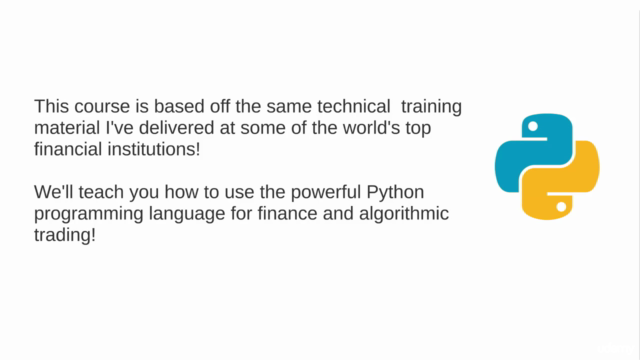Python for Financial Analysis and Algorithmic Trading

Why take this course?
👨🏫 Course Instructor: José Portillacourse title: "Python for Financial Analysis and Algorithmic Trading" 🚀
Course Headline: 📈 Dive into the World of Python for Financial Analysis and Algorithmic Trading!
Welcome to Python for Financial Analysis and Algorithmic Trading!Are you eager to unlock the secrets behind the scenes of financial analysis and algorithmic trading, and harness the power of Python to delve into the complex world of finance? If so, this is the perfect course for you! 🌟
Course Description:
This comprehensive course will be your guide through the intricacies of using Python in Finance and Algorithmic Trading. We'll kick off by mastering the basics of Python and then dive into the core libraries that are the bedrock of the Py-Finance Ecosystem - numpy, pandas, matplotlib, statsmodels, zipline, and Quantopian, among others. By the end of this course, you'll have a robust skill set to perform financial data analysis, develop trading algorithms, and make informed investment decisions. 📊
What You Will Learn:
This course is meticulously designed to cover the essential tools and techniques used by financial professionals. Here's what you can expect to master:
- Python Fundamentals ✅
- NumPy for High Speed Numerical Processing 📊
- Pandas for Efficient Data Analysis ✨
- Matplotlib for Data Visualization 📈
- Using pandas-datareader and Quandl for data ingestion 🚀
- Pandas Time Series Analysis Techniques ⏳
- Stock Returns Analysis 💰
- Cumulative Daily Returns 🔄
- Volatility and Securities Risk 🔥
- EWMA (Exponentially Weighted Moving Average) 📉
- Statsmodels for Statistical Analysis 📊
- ETS (Error-Trend-Seasonality) Models ⏳
- ARIMA (Auto-regressive Integrated Moving Averages) Models 📉
- Auto Correlation and Partial Auto Correlation Plots 📈
- Sharpe Ratio Calculation 💹
- Portfolio Allocation Optimization 🏗️
- Efficient Frontier and Markowitz Optimization 📊
- Types of Funds 💰
- Order Books 📄
- Short Selling Strategies 🎫
- Capital Asset Pricing Model (CAPM) 💼
- Stock Splits and Dividends 🏦
- Efficient Market Hypothesis 📈
- Algorithmic Trading with Quantopian 🚀
- Futures Trading Basics 🌐
- Understanding the Psychology of Trading 🧠
- Backtesting Your Algorithms ⏰
Why Take This Course?
- Real-World Applications: Learn by doing with real financial data.
- Skill Mastery: Gain in-depth knowledge and practical experience in Python for finance.
- Career Advancement: Enhance your CV and open up new career opportunities in finance, data science, or algorithmic trading.
- Community Support: Join a community of like-minded learners and professionals.
Your Instructor: José Portillacontactable at [instructor's contact information]
José is a seasoned financial analyst with over 10 years of experience in the finance sector, specializing in Python for Financial Analysis and Algorithmic Trading. He has a passion for teaching and a knack for simplifying complex concepts, making him the ideal guide on your journey to mastering these skills.
Ready to Embark on Your Financial Analysis and Algorithmic Trading Journey? 🚀
Enroll now and transform your data into actionable insights with Python! 💡
Course Gallery




Loading charts...
Comidoc Review
Our Verdict
This course offers valuable insights into Python libraries critical for financial analysis. However, the reliance on the now-defunct Quantopian platform hinders the overall experience. With a more user-friendly update utilizing Blueshift, this course could better serve aspiring traders and analysts.
What We Liked
- Comprehensive coverage of essential Python libraries for financial analysis and algorithmic trading, including NumPy, Pandas, Matplotlib, and statsmodels
- Provides a strong foundation in time series analysis, financial statistics calculation, and portfolio optimization techniques
- High-quality instruction with clear explanations and real-world examples
- Recent update addresses the decommissioning of Quantopian to some extent by introducing Blueshift, though it is not as polished or user-friendly
Potential Drawbacks
- Algorithmic trading section relies on now-defunct Quantopian platform, causing numerous issues and preventing learners from completing the course as intended
- Limited practical exercises throughout the course resulting in a lack of hands-on experience for learners
- No clear guidance on setting up the environment or dealing with installation problems for different operating systems
- Recent update introducing Blueshift is not as polished, causing some frustration and confusion for learners